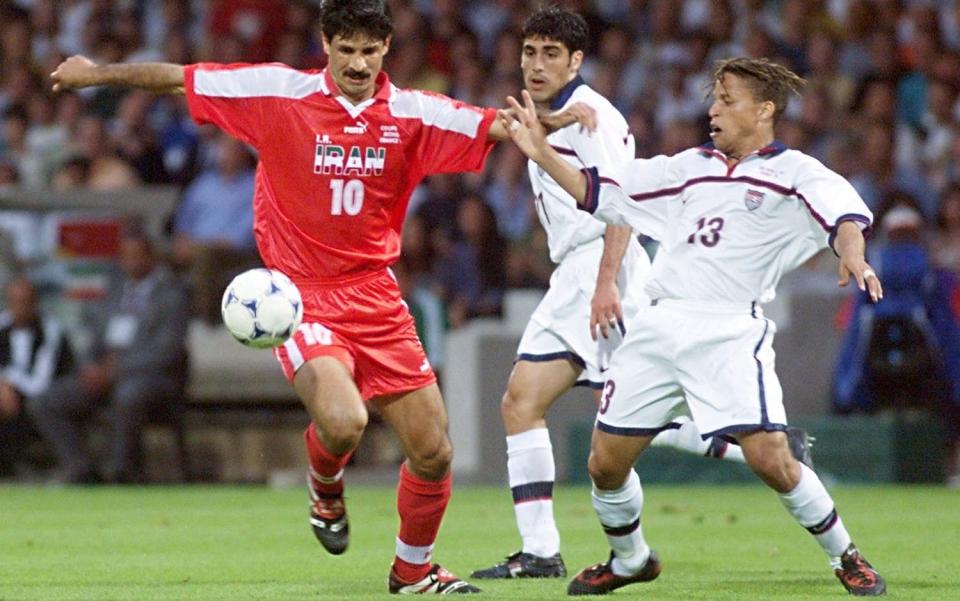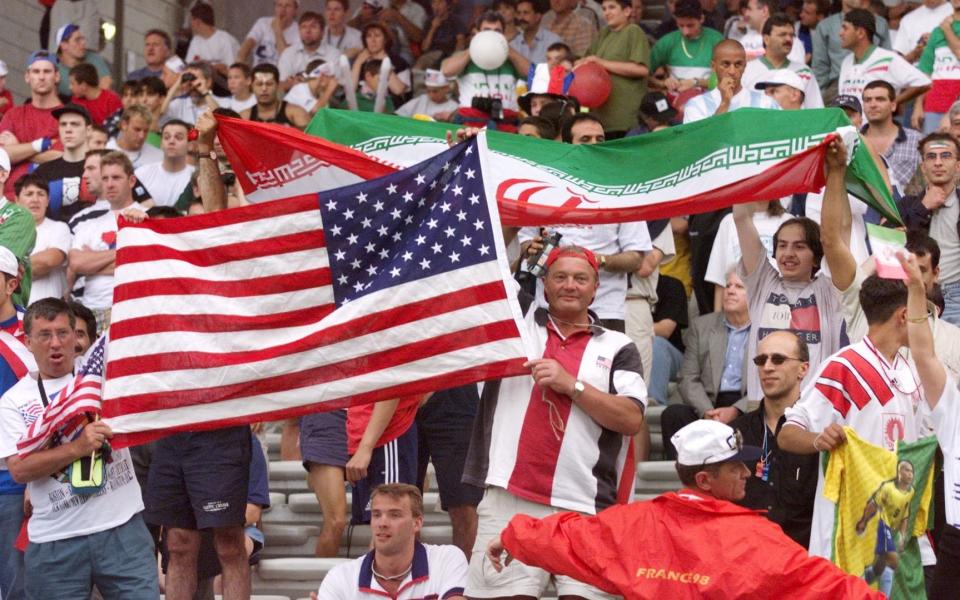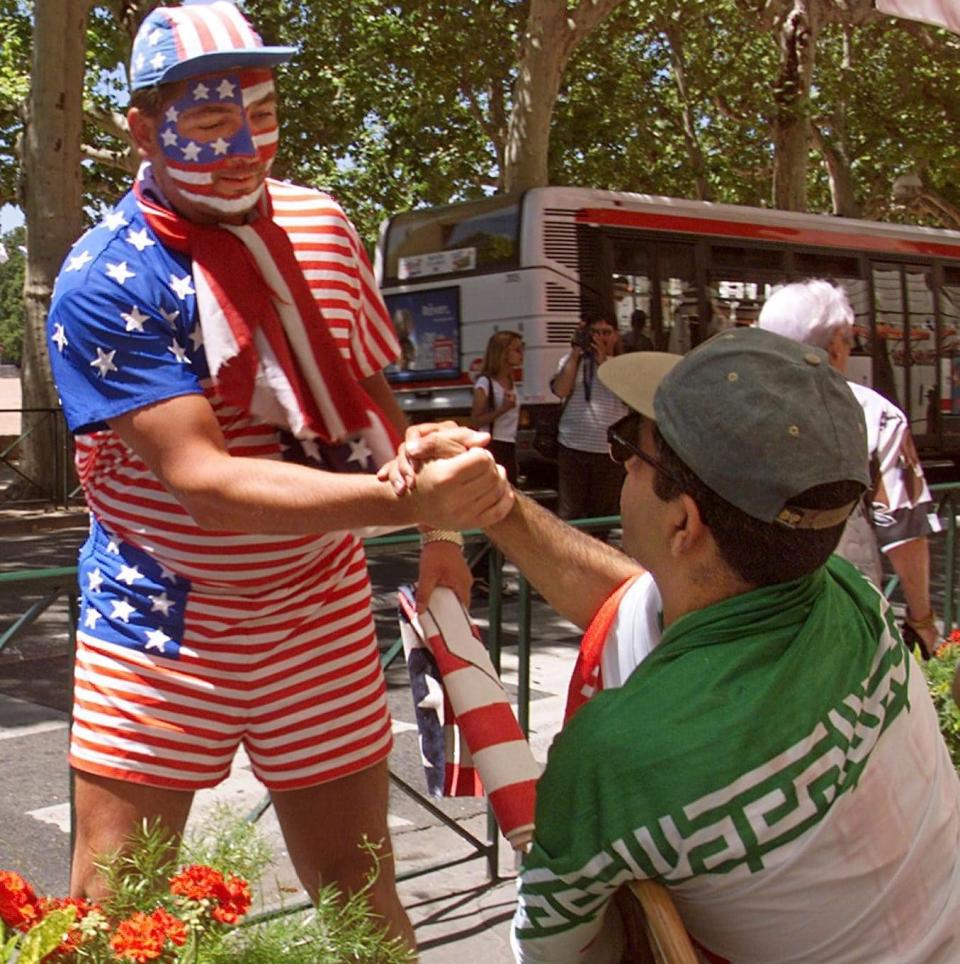USA vs Iran at World Cup '98: Remembering 'The Mother of All Games'

The United States will play Iran for only the second time in World Cup history on Tuesday. The game will be laced with a political undercurrent amid civil unrest in Iran and a major row over how their flag was displayed by the US team on social media, but pre-match tensions do not even compare to what unfolded in Lyon at the 1998 World Cup. It was billed as 'The Mother of all Games'.
Background and build-up
The 1979 revolution in Iran had resulted in the US-backed Shah regime fleeing the country and Ayatollah Ruhollah Khomeini becoming leader of the new republic. Shah, who was accused of committing crimes against Iranian citizens, was granted entry to the USA.
The new Iranian government denounced America, referring to it as ‘the great Satan’ and, in November '79, a group of young Iranian militants stormed the US embassy in Tehran and took more than 50 people hostage. This lasted for 444 days and the US subsequently severed diplomatic ties (watch video below). The US also provided support to Saddam Hussein’s Iraq regime during their eight-year war with Iran.
Club football was not re-established in Iran until 1989, and 1998 would be the first time they qualified for the World Cup in two decades. Mehrdad Masoudi, an Iranian working for Fifa at the 1998 World Cup, says “people were dancing in the streets, openly drinking alcohol” in Tehran after they beat Australia to qualify. “The Revolutionary Guard didn't do anything about it because they were also so happy,” he adds.
After Iran were then drawn against the United States, the mood was summed up by the Iranian striker Khodadad Azizi. “We will not lose” he said, before referencing the Iran-Iraq war: “Many families of martyrs are expecting us to win. We will win for their sake.”
Fifa was desperate that the game should not be overshadowed by the political tensions and appointed a Swiss referee, Urs Maier, as a sign of neutrality.
Bill Clinton, the US President, videotaped a message to the Iranian people saying that he hoped the game "can be another step toward ending the estrangement between our nations" (watch video below) but there were public pre-match tensions over a movie screened on French television called ‘Not Without My Daughter’. Iranians felt that it showed them in a bad light – striker Ali Daei called it “a lie” – but US defender Alexi Lalas praised the film.
A major security operation was being rolled out, with plain-clothes police officers deployed at the USA’s team training sessions and hotel amid reports that they were being targeted by radical groups.
The fixture was scheduled for June 21 – the second round of group matches – and both the USA and Iran desperately needed to win following respective defeats by Germany and Yugolsavia.
The match
A major problem occurred 24 hours before the game when word reached Masoudi at Fifa that Iran’s Supreme Leader Ali Khamenei – who remains leader to this day – had insisted that the players must not walk towards the Americans before the game. As the supposed ‘away’ team, that was the Fifa protocol. “So we came to the conclusion that, instead of who walks towards who, we will have a joint team photo taken,” says Masoudi. “The American players received a bouquet of white flowers – a symbol of peace – from the Iranian players and it was a magnificent scene.”
That on-field harmony, however, could not disguise the frantic efforts that were going on behind the scenes. Intelligence had been received about two large groups of fans – one about 3,000 strong – who were planning to unveil political banners and another who officials feared would invade the pitch.
There were also reports that an Iraq-based terrorist group funded by Saddam Hussein had bought tickets and was planning some sort of protest.
TV cameramen and photographers were instructed to ignore fans with political messages. “I told the Fifa security officer that I felt something big was about to happen,” says Masoudi. “We had 150 armed police, which was unprecedented for a World Cup match. I said we needed to bring these 150, and surround this group of fans, in order to stop them from invading the pitch.”
The tension was sensed by the players. “It was like a war zone, that stadium had helicopters flying over and armed guards with machine guns walking around because of the political tension between the two countries,” said one player, who did not wish to be named.

Among the journalists in Lyon that day was The Telegraph’s sports writer Jim White. The majority of Iranian fans, he says, were anti-government and living in Europe or the United States. “The security were confiscating political posters from fans as they went in.”
The American fanbase, he recalls, was rather different than your typical football supporter. “It looked like a Harvard Business School outing – the entire contingent had chinos and blazers – the atmosphere in the crowd was friendly.”
The match was also played in a good on-field spirit, with Iran taking a first-half lead before withstanding considerable US pressure to score a second goal on the counterattack. The USA would hit the post three times but could only register with Brian McBride’s late consolation. "It was like the post had a magnet on it," said McBride. The USA were out and there were celebrations on the streets of Tehran.
The aftermath
US manager Steve Sampson said he was pressured by Fifa and the US football federation into playing down political tensions and now regrets such overt diplomacy. He has also since claimed that he was informed the Iran players had their passports confiscated at half-time and were told that they must win in order to re-enter the country.
“A coach’s job is to use any and every tool available to him to prepare his team,” he told Time magazine. “So many Americans have been hurt so dramatically by the Iranian regime. We could have played for them.”
Others have emphasised a broader view. "We did more in 90 minutes than the politicians did in 20 years,” said USA midfielder Jeff Agoos.

Indeed, the match was perceived so successful that a repeat friendly fixture was arranged 18 months later in California. A multitude of logistical challenges would follow, including a waiver that would exempt the Iran players from having their fingerprints or photographs taken upon arrival in the US.
Iran duly became only the second sporting team – after a wrestling squad – to set foot on US soil following the revolution in 1979. Another huge security operation included a decoy Iran team bus and closed airspace over a game that saw more than 50,000 fans watch the teams play out a 1-1 draw.
"In many respects this match was far more significant because it was a friendly and it needed the cooperation of both sides," says Masoudi, who still works for Fifa. "It could only have happened if the match at France '98 was a success. It [1998] was a moment in history that brought people together.

"What happened on the pitch during those two hours was a lesson to the world at large that despite our differences, despite the fact that we may come from different backgrounds, we can live peacefully together. Both sides happily exchanged jerseys and they became good friends. To be part of the team that put together that match peacefully was, no doubt, the greatest moment of my personal and sporting life.”

 Yahoo Sport
Yahoo Sport 





































